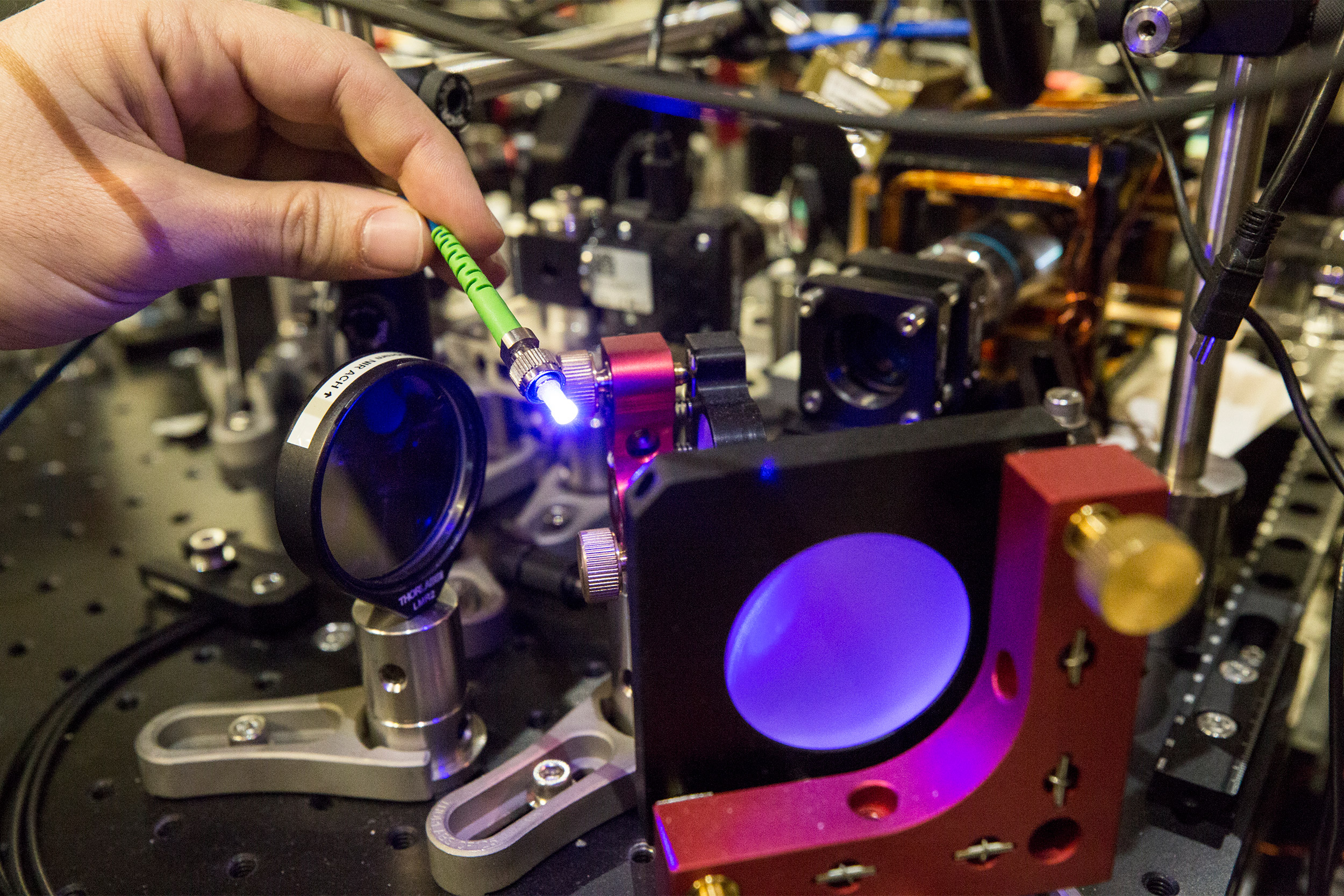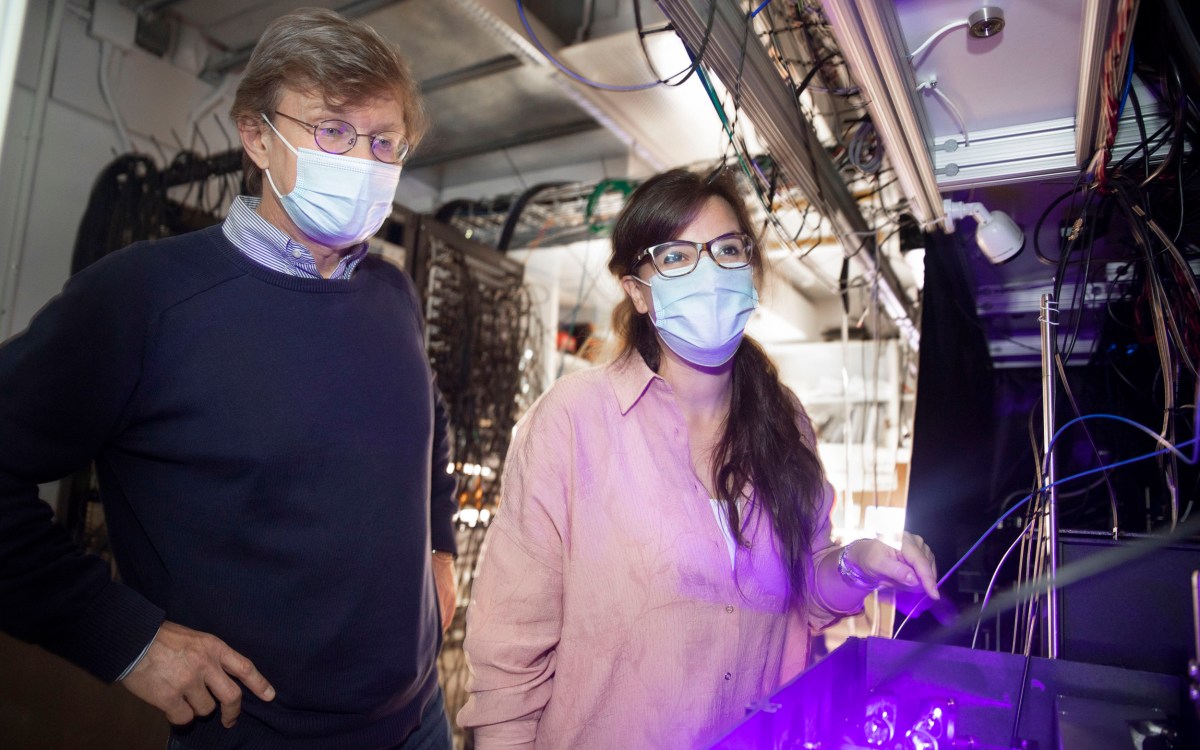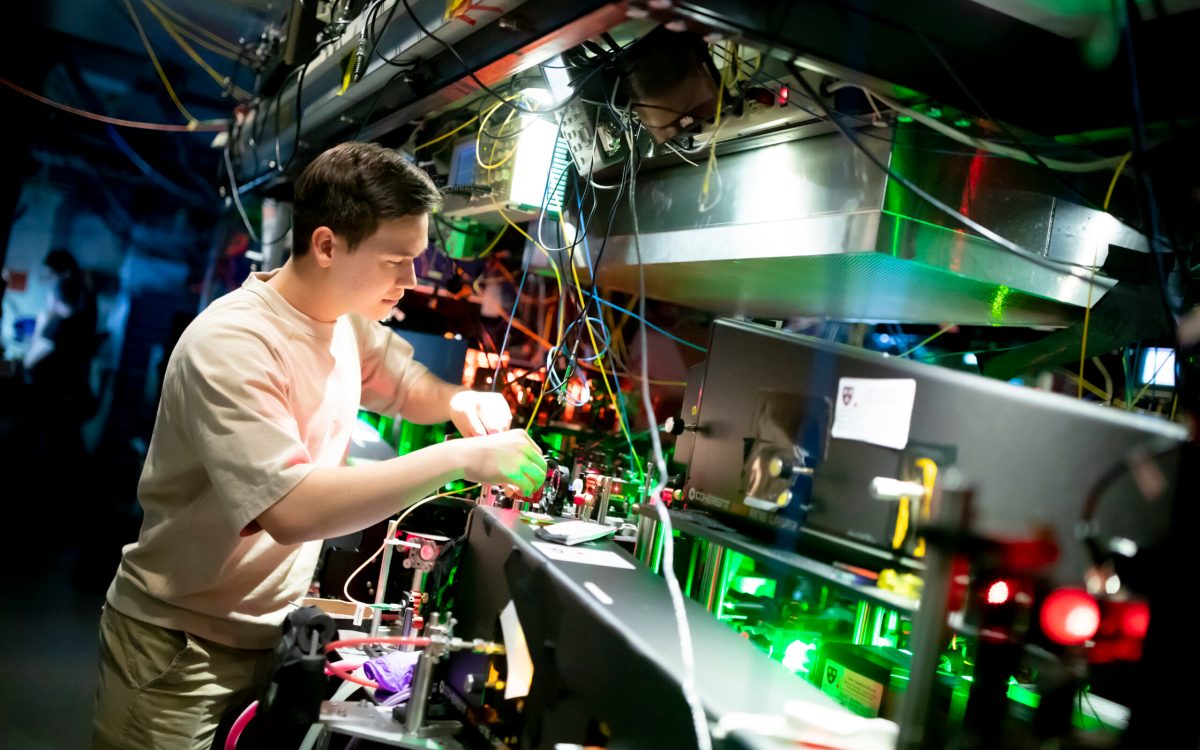
Harvard researchers work with a quantum simulator.
File photo by Jon Chase/Harvard Staff Photographer
Harvard partners with Amazon Web Services in quantum internet push
Faculty leaders explain implications for the field — and the future
Harvard University and Amazon Web Services (AWS) on Monday launched a strategic alliance to advance fundamental research and innovation in quantum networking.
This effort provides significant funding for faculty-led research at Harvard and will build capacity for student recruitment, training, outreach, and workforce development in this key emerging technology field. The initiative focuses on driving rapid progress toward specific research aims in quantum networking at the Harvard Quantum Initiative (HQI).
Through a three-year research alliance, enabled by Harvard’s Office of Technology Development, AWS will provide support of faculty-led and designed research projects at HQI in quantum memories, integrated photonics, and quantum materials. The principal goal of the research projects is to develop foundational methods and technologies for what eventually will become a quantum internet.
Separate philanthropic support from AWS will help Harvard train and support graduate students and postdoctoral researchers, especially with the goal of welcoming aspiring scientists and engineers from underrepresented backgrounds.
“By working together, academia and industry can accelerate discovery and technological progress,” said Harvard Provost Alan M. Garber. “Through this alliance with AWS, we will bring scientific scholarship and education to bear on some of the most exciting frontiers in quantum science. Together we will advance the goals of the Harvard Quantum Initiative, an interfaculty initiative that exemplifies the rewards of collaboration across different scientific domains.”
“Quantum networking is an emerging space with promise to help tackle challenges of growing importance to our world, such as secure communication and powerful quantum computing clusters,” said Antia Lamas-Linares, quantum networking lead at AWS. “The collaborative initiative between AWS and Harvard will harness top research talent to explore quantum networking today and establish a framework to develop the quantum workforce of the future.”
A portion of the funding will also allow an upgrade to the quantum fabrication capabilities of the NSF-supported Center for Nanoscale Systems at Harvard, a critically important facility for nanofabrication, materials characterization, soft lithography, and imaging, with locations in Cambridge and at the Science and Engineering Complex in Allston.
These efforts build upon rising momentum. Harvard announced last year a new Ph.D. program in Quantum Science and Engineering, and is finalizing plans to comprehensively renovate an existing campus building into a new physical home for HQI, as well as a quantum hub, a project made possible by gifts from Stacey L. and David E. Goel ’93 and several other alumni.
The Gazette spoke to the four faculty members leading the projects that make up the research alliance: HQI codirector Evelyn Hu, the Tarr-Coyne Professor of Applied Physics and Electrical Engineering; Marko Lončar, Tiantsai Lin Professor of Electrical Engineering; Mikhail Lukin, the George Vasmer Leverett Professor of Physics and co-director of HQI; and Hongkun Park, Mark Hyman Jr. Professor of Chemistry. They spoke about the research at the center of the initiative, how it will help students, and how it builds on a long history of advances at Harvard. The interview has been edited for clarity and length.
Q&A
Evelyn Hu, Marko Lončar, Mikhail Lukin, and Hongkun Park
GAZETTE: This is an exciting alliance between HQI and AWS. What does it represent for the study of quantum science and why is important?
HU: First, with quantum much of our study is still rooted in understanding the fundamentals, the basic science — the chemistry, the physics, the engineering — to understand what it’s all about. Yet, at the same time, we have this incredible opportunity, realizing that there are applications that are making their way to the commercial world. This alliance with AWS allows us to seamlessly bridge the fundamentals in diverse areas, more typical of an academic environment, informed by the understanding of where the applications are, and how to make those applications actually emerge from the fundamentals. This is done in concert with those who understand those applications and what it means to take the science, engineering, and technology into the commercial sector, and therefore into society. So, the alliance represents an unprecedented opportunity for all of us in the University, and particularly for our students, to gain this perspective and to gain this opportunity.
GAZETTE: Speaking of students, what specifically is critical about training what’s being called “Generation Q”?
PARK: This type of work requires a truly interdisciplinary collaboration among scientists and technologists of different expertise. It also represents a relatively rare — but soon to be much more common — collaboration between academia and industry. As such, it provides unique yet fertile educational grounds for students.
HU: Given the broad scope of the foundational platforms that are yet to be constructed, the very different nature of quantum information, and the spanning of the distance to systems and applications, training Generation Q requires a substantial marshaling of very diverse talents, interests, expertise, a rewriting of the foundational education and training rules. New types of industrial-academic collaborations are also critical to span fundamentals to systems: Students should have the opportunity to participate in collaborations, and to directly understand the different expertise, points of view, and “give and take” that are needed.
LONČAR: In my opinion, we are witnessing the birth of a new scientific discipline — quantum engineering. This is similar to the situation many moons ago when electrical engineering was born out of physics, for example. Industrial relationships like the one we are developing with AWS are crucial for training a new generation of engineers.
GAZETTE: Does the alliance advance how academia and industry work together, especially in this region?
LUKIN: Initiatives of this kind — bridging cutting-edge academic research and leading industry partners — are critical to the emergent quantum industry and quantum ecosystem in the U.S. as a whole and in the Boston area specifically. We believe that the Boston area, with academic institutions such as Harvard and MIT, and a range of startups in the quantum domain, already plays a leading role in worldwide quantum effort, and we view such partnerships as being essential for the continued leadership in this area.
“We are talking here about not just the next generation of internet, but about the internet with fundamentally new capabilities.”
Mikhail Lukin, George Vasmer Leverett Professor of Physics and co-director of HQI
GAZETTE: The projects fall into three areas: quantum memories, integrated photonics, and quantum materials. What is your goal here?
PARK: Our main goal is to realize the promise of quantum repeaters, which is the backbone of the quantum internet. In the quantum internet, communication will be performed using individual photons that cannot be copied or amplified due to their quintessential quantum nature. One of the issues is that individual photons will get lost, even within the optical fibers, within about 100 kilometers or 200 kilometers. So, every 100 kilometers or so, we either need to convert individual photons to classical information or somehow “repeat” them without really measuring them. Quantum repeaters that Misha’s [Mikhail’s] group is developing provide a solution to this problem.
Marko’s team is performing another very critical task of linking quantum repeaters to the existing optical fiber network we use today. To do that, you have to change the wavelength of the photon from optical to telecom range.
Evelyn and I are working on exploring new materials for the next generation’s quantum repeaters, so that we can make them work at elevated temperatures, instead of the extremely low temperatures that we are currently working in.
HU: Part of the goal in linking these project areas is ultimately the creation of a system. This systems-based approach is rarely carried out in universities. We need the resources, the longevity, the knowledge of external markets and societal demands. This new collaboration provides that complement.
“The first real-world application of the quantum internet is genuinely secure, unhackable communication.”
Hongkun Park, Mark Hyman Jr. Professor of Chemistry
GAZETTE: What is the quantum internet? What can it do?
LONČAR: One feature is security of information, because the shuttling of quantum states means you can detect the presence of any eavesdropper. The second is coherence, basically a way to access quantum computers — once they become ready for primetime — in completely quantum fashion. For example, this could allow a user to generate a complex quantum state, send it via quantum internet — along with the quantum algorithm — to the quantum computer, do computation, and then retrieve the quantum state that is the result of the computation. Such an end-to-end quantum system — “quantum cloud,” as I like to call it — would result in unprecedented computational power and security.
GAZETTE: Could the quantum internet be as profound an advance as the internet?
HU: My belief is that the advances provided by a quantum internet will be truly profound, in ways that we cannot, at the moment, anticipate. In general, humans have always been limited in our ability to realize or predict the implications of a new technology: Early on, no one quite knew what to do with transistors. Who knew what profound changes the personal computer or the smartphone would create? Similarly, what might we be able to do if we were able to send, receive, process and store information far more quickly and securely than we currently can? Would we multitask, integrate ever more sensors to seamlessly project different visions of the real world?
PARK: In my mind, the first real-world application of the quantum internet is genuinely secure, unhackable communication. As Evelyn said, like other profound technological developments, it’s anybody’s guess exactly how things will unfold after.
LUKIN: We are talking here about not just the next generation of internet, but about the internet with fundamentally new capabilities. Apart from secure communication, applications could include networked quantum computers with fundamentally new possibilities. One example is “blind” quantum computing where computation can be executed on a quantum cloud without anybody — including parties running the cloud — having a possibility to find out what is being computed, new types of distributed sensor networks, secure voting and decision-making, and more.
This is an inflection point, where a new scientific field is being born, involving the interface between quantum physics, chemistry, computer science, and device engineering. Analogies from the past include the emergence of new fields such as electrical engineering or computer science. They emerged from disciplines such as physics or mathematics and both had a profound impact on science and society.
GAZETTE: This alliance builds on fundamental work that has been done at Harvard for decades. Can you give us some examples of this history?
LUKIN: If we go back as far as the 1950s and 1960s, important foundational work has been done both in terms of understanding quantum properties of light, how to think about them, how to describe them, what does it mean for that light to be quantum. That was foundational work done by Roy Glauber, a Nobel laureate. In parallel, there has been also some truly foundational work by Ed Purcell, another Harvard physics professor and another Nobel prize winner, involving the interaction of radiation with matter. That resulted in something which is called the Purcell effect, which is actually the phenomenon we use to make single photons interact strongly with single atoms.
About 20 years ago, another breakthrough happened at Harvard: Together with several collaborators around the world, we theoretically developed the idea of quantum repeaters — the basic building blocks of quantum internet that can correct errors in quantum transmission. That included a conceptual way to build quantum repeaters using memories and also specifically ideas on how to use atom-like impurities in diamonds to build them in practice. Later we carried out early work on manipulating individual, atom-like defects in diamonds. Very soon we realized that in order to make these things practical someday, we not only needed basic physics, but we also needed chemistry, photonic engineering, material science. This is how this collaboration between our various groups started. Another very important breakthrough happened in Marko’s group when they developed a technique to make nanoscale devices out of diamond — something that was completely impossible previously. This was essential for realizing the practical quantum network nodes that we eventually demonstrated in our laboratories. And from that, Marko’s team realized that that the best approach was to try to make small nanoscale devices out of diamond.
So, it’s been decades of work, starting from very basic things like understanding the fundamental interactions between single atoms and single photons, to much more practical questions about how to make these completely futuristic devices — two decades ago, it was totally unthinkable that we could make any devices out of diamond.
Where we are now is a result of several kinds miracles, some minor and some major. What we want to do now is to really take these building blocks and start making devices and combine them into systems, as Evelyn said, systems that will have capabilities that are completely unprecedented.
HU: Misha said it’s a series of miracles. Science is always miraculous, but I think it’s more than that. I think it’s long-term commitment. What Misha describes — going back into the 1950s and certainly more recently — is playing the long game, the commitment to possibilities, and to working with people, even at early stages, when possibilities are not yet fully understood, much less realized. It’s only by taking that long view, making a commitment to collaboration — and the underlying trust that holds collaborations together — that the miracles actually manifest themselves.








